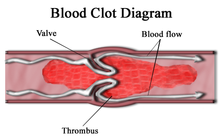thrombus

Thrombus (plural thrombi; from ancient Greek θρόμβος thrómbos , German 'lump' , ' plug '; coagulum ) is the medical term for a blood clot in a blood vessel or in the heart . In contrast, the term clot is used for the extravascular blood clot .
Thrombi can develop in both the venous and arterial parts of the bloodstream. A thrombus can block the vessel at its point of origin or it can loosen, be carried away by the bloodstream and cause blockages elsewhere, which lead to a failure of the blood supply to organs. In this case one speaks of an embolism or thromboembolism, the blood clot is then also referred to as an embolus.
The clinical pictures triggered by thrombi include infarct , ischemic stroke , thrombosis or, as a consequence, pulmonary embolism .
Thrombi form z. B. after vascular injuries, in order to close the injured point in the vessel from the inside and to avoid major blood loss. In rarer cases, thrombi can also form spontaneously and without previous injury or other external influences, e.g. B. as a result of disorders of blood coagulation ( hemostasis ) or greatly reduced flow rate of the blood, due to coagulation due to an increased content of erythrocytes .
In many cases, thrombi are completely dissolved again by the healthy body itself without the above-mentioned. Leading to clinical pictures.
During the autopsy , the pathologist must distinguish thrombi that have formed in vivo from a corpse clot . The latter can easily be pulled out of the affected vessel, since it is not connected to the vessel wall.
Types of thrombus
According to composition
- White thrombus (excretory thrombus): fibrin-rich thrombus
- Red thrombus (coagulation thrombus): blood-rich thrombus
- Platelet thrombus: thrombus that consists predominantly of platelets
- Fibrin thrombus: Thrombus that consists only of fibrin .
- Phlebolite: also venous stone, a calcified vein thrombus in calcinosis dystrophica
According to place of origin
- Arterial thrombus: mostly mural thrombus mainly formed by platelets and fibrin.
- Venous thrombus: red thrombus often formed in the area of the valves due to stasis
- Atrial thrombus : atrial fibrillation can lead to thrombus formation in the atrium (especially in the auricle).
Thrombus formation inhibitors
- Platelet aggregation inhibitors such as acetylsalicylic acid (ASA; only for arterial thrombi) or clopidogrel
- Heparin
- 4-hydroxycoumarins , e.g. B. Phenprocoumon
- Thrombin antagonists
- Direct oral anticoagulants (DOAK or DOAKs)
Web links
- Wissenschaft.de: Stretching exercises for blood clots. Via an article in Science (W. Liu et al., Vol. 313, p. 634).
- Donald Schreiber: Deep Venous Thrombosis and Thrombophlebitis. emedicine 2009 (English)
Individual evidence
- ↑ Heart attack and stroke: when thrombi clog the blood vessels. In: Deutsche Apothekerzeitung . September 7, 1997, Retrieved June 28, 2019 .
- ↑ Olaf Dierstein: Diagnosis: Thrombosis. In: Deutsche Apothekerzeitung . June 11, 2015, accessed June 28, 2019 .

